

Click on images to see a larger version.
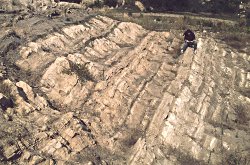 In
order to understand deformed rocks we need to have some idea of their organisation - their architecture
- before they were deformed. We can start on a grain scale.
In
order to understand deformed rocks we need to have some idea of their organisation - their architecture
- before they were deformed. We can start on a grain scale.
Many rocks show layering. This might be defined by systematic variations in grain size. One layer could have predominantly large grains while other layers might be dominated by smaller grains. Another type of layering might result from systematic variations in the distribution of the composition (mineralogy) of grains. This type of organisation has a general term: LOCATION FABRIC.
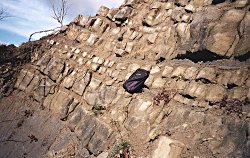 In sedimentary
rocks the systematic development of location fabric is known as BEDDING. For example, a
sandstone may display bedding that is defined by systematic variations in grain size through a section.
In sedimentary
rocks the systematic development of location fabric is known as BEDDING. For example, a
sandstone may display bedding that is defined by systematic variations in grain size through a section. 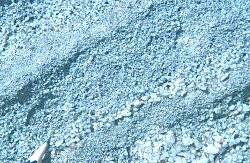 In
a rock sequence bedding might also be defined by alternations of layers that are predominantly composed
of grains of the mineral calcite - in which case the rock layer would be called a limestone, and
layers composed of clay minerals - forming a layer of clay or mudstone. The bedding then would be
an example of a location fabric defined by variations in composition.
In
a rock sequence bedding might also be defined by alternations of layers that are predominantly composed
of grains of the mineral calcite - in which case the rock layer would be called a limestone, and
layers composed of clay minerals - forming a layer of clay or mudstone. The bedding then would be
an example of a location fabric defined by variations in composition.
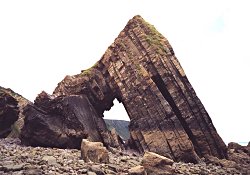 Location
fabric can be displayed by igneous rocks - especially those that crystallised gradually
on the sides of magma chambers. In these situations subtle variations in the chemistry or physical
conditions in the magma chamber can cause particular minerals to crystallise from the melt. Changing
these conditions may cause a different mineral to crystallise out. So variations in crystallisation
can be manifest by layering defined by alternations of different composition (different minerals).
Location
fabric can be displayed by igneous rocks - especially those that crystallised gradually
on the sides of magma chambers. In these situations subtle variations in the chemistry or physical
conditions in the magma chamber can cause particular minerals to crystallise from the melt. Changing
these conditions may cause a different mineral to crystallise out. So variations in crystallisation
can be manifest by layering defined by alternations of different composition (different minerals). 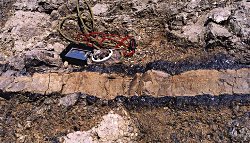 The
general term COMPOSITIONAL BANDING is used to describe the layering. Igneous rocks can also show location
fabrics defined by systematic variations in grain size - particularly when a volume of magma cools
at different rates.
The
general term COMPOSITIONAL BANDING is used to describe the layering. Igneous rocks can also show location
fabrics defined by systematic variations in grain size - particularly when a volume of magma cools
at different rates. 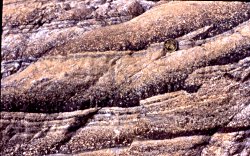 Fine-grained,
chilled margins on the flanks of dykes and sills intruded at shallow crustal levels are examples of
such location fabrics.
Fine-grained,
chilled margins on the flanks of dykes and sills intruded at shallow crustal levels are examples of
such location fabrics.
For both sedimentary and igneous rocks, the location fabrics are formed by the same processes that
make the original rocks themselves. So in this sense they can be considered as primary structures.
This is useful for structural geologists because we have a marker of the organisation of rocks from
before deformation. For sedimentary rocks bedding is especially useful. 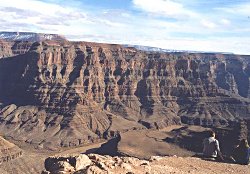 Sedimentary
layers are commonly laid down horizontally with bedding level, planar and continuous in the original
undeformed state. So if we find beds that are strongly inclined, folded and cut and offset we are able
to recognise deformation and begin to analyse it. In general the location fabrics in igneous rocks
are less useful simply because we can be less certain about the original organisation and scale of
the features. Compositional banding will reflect some aspect of the geometry of the magma chamber within
which the igneous rock crystallised - we can assume that it was originally level, planar or even continuous.
But there are still uses to igneous rocks in structural geology - as we'll see later.
Sedimentary
layers are commonly laid down horizontally with bedding level, planar and continuous in the original
undeformed state. So if we find beds that are strongly inclined, folded and cut and offset we are able
to recognise deformation and begin to analyse it. In general the location fabrics in igneous rocks
are less useful simply because we can be less certain about the original organisation and scale of
the features. Compositional banding will reflect some aspect of the geometry of the magma chamber within
which the igneous rock crystallised - we can assume that it was originally level, planar or even continuous.
But there are still uses to igneous rocks in structural geology - as we'll see later.
An aside: bedding in sedimentary rocks
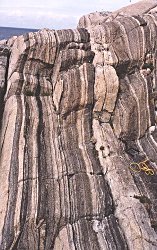 Metamorphic
rocks can show location fabrics too. In general these are defined by the distribution of different
minerals forming compositional banding. In coarse-grained (grains readily visible with the naked eye)
metamorphic rocks such structures are generally termed GNEISSIC BANDING. But this is not a primary
structure - because metamorphic rocks themselves originate as either sedimentary or igneous rocks.
Gneissic banding is generally formed by the re-organisation of the original rock's chemical constituents
into layers within which particularly minerals are concentrated. Only rarely will this banding mimic
any primary layering (igneous compositional banding or sedimentary bedding). In general gneissic banding
is new. Nevertheless in some regional metamorphic belts gneissic banding can have remarkably uniform
orientations (leading early geologists to mis-interpret as mimicking bedding). So if we have reason
to believe that gneissic banding had a reasonably simple, planar and parallel form prior to a particular
deformation episode we can use it to recognise later folds and folds.
Metamorphic
rocks can show location fabrics too. In general these are defined by the distribution of different
minerals forming compositional banding. In coarse-grained (grains readily visible with the naked eye)
metamorphic rocks such structures are generally termed GNEISSIC BANDING. But this is not a primary
structure - because metamorphic rocks themselves originate as either sedimentary or igneous rocks.
Gneissic banding is generally formed by the re-organisation of the original rock's chemical constituents
into layers within which particularly minerals are concentrated. Only rarely will this banding mimic
any primary layering (igneous compositional banding or sedimentary bedding). In general gneissic banding
is new. Nevertheless in some regional metamorphic belts gneissic banding can have remarkably uniform
orientations (leading early geologists to mis-interpret as mimicking bedding). So if we have reason
to believe that gneissic banding had a reasonably simple, planar and parallel form prior to a particular
deformation episode we can use it to recognise later folds and folds.